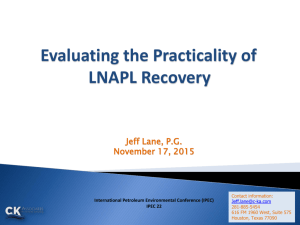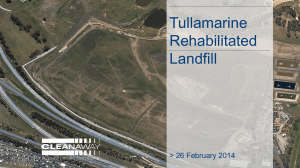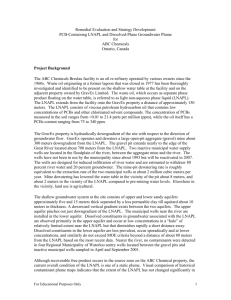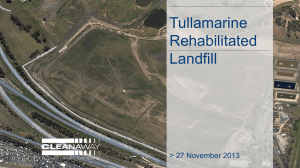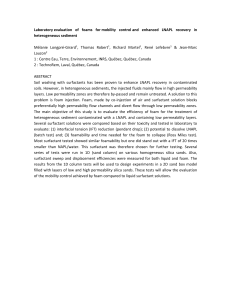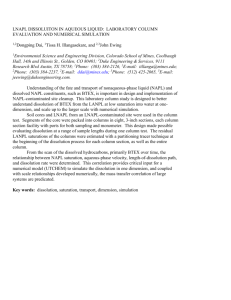What Is LNAPL?
advertisement
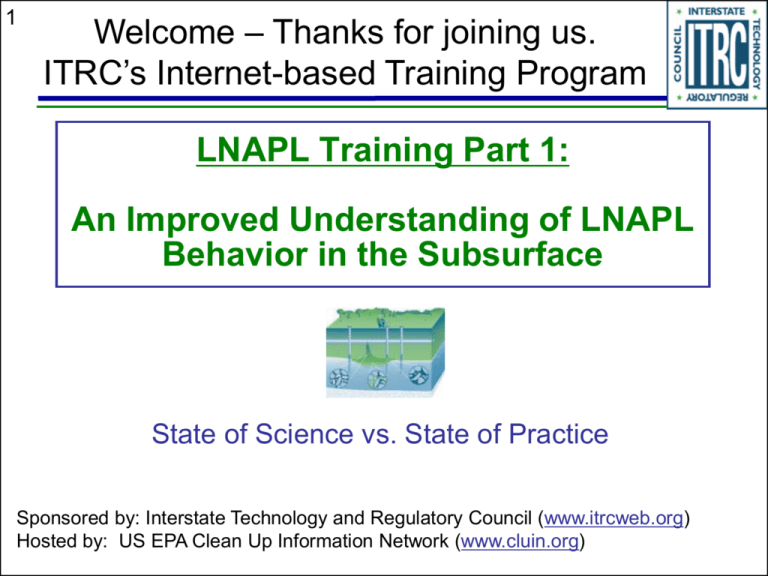
1 Welcome – Thanks for joining us. ITRC’s Internet-based Training Program LNAPL Training Part 1: An Improved Understanding of LNAPL Behavior in the Subsurface State of Science vs. State of Practice Sponsored by: Interstate Technology and Regulatory Council (www.itrcweb.org) Hosted by: US EPA Clean Up Information Network (www.cluin.org) 2 Housekeeping Download slides as PPT or PDF Go to slide 1 Move back 1 slide Move forward 1 slide Course time is 2¼ hours Question & Answer breaks • Phone - unmute #6 to ask question out loud Simulcast - ? icon at top to type in a question Turn off any pop-up blockers • Go to last slide Go to seminar homepage Submit comment or question Report technical problems Move through slides • Arrow icons at top of screen • List of slides on left Feedback form available from last slide – please complete before leaving This event is being recorded Copyright 2015 Interstate Technology & Regulatory Council, 50 F Street, NW, Suite 350, Washington, DC 20001 3 ITRC (www.itrcweb.org) – Shaping the Future of Regulatory Acceptance Host organization Network • State regulators All 50 states, PR, DC Disclaimer • Full version in “Notes” section • Partially funded by the U.S. government • Federal partners ITRC nor US government warranty material ITRC nor US government DOE DOD endorse specific products EPA • ITRC Industry Affiliates Program • ITRC materials copyrighted Available from www.itrcweb.org • Technical and regulatory guidance documents • Academia • Community stakeholders • Internet-based and classroom training schedule • More… 4 Meet the ITRC Trainers John Menatti Utah Department of Environmental Quality Salt Lake City, Utah 801-536-4159 jmenatti@utah.gov Sanjay Garg Shell Global Solutions Houston, Texas 281-544-9113 sanjay.garg@shell.com Ian Hers Golder & Associates Vancouver, British Columbia 604-298-6623 ihers@golder.com 5 ITRC LNAPL Team ITRC LNAPL Team formed in July 2007 Collaborative effort involving State and Federal Regulators, Consultants, Industry Representatives, and Stakeholders Stakeholders 5% Industry Representatives 19% Consultants 31% State Regulators 35% Federal Agencies 10% 6 Why did ITRC form an LNAPL Team? LNAPL is present at thousands of sites State regulatory agencies have a backlog of LNAPL sites that are not effectively approaching an endpoint, i.e., no further action (NFA) LNAPL poses technical and regulatory challenges For example, for leaking underground storage tank (LUST) sites, what does removal of free product to the maximum extent practicable mean? 7 ITRC LNAPL Team Documents and Training April 2009: Technology Overview document on LNAPL Natural Source Zone Depletion December 2009: LNAPL Technical/Regulatory Guidance document 2010 - 2015: LNAPL Internet-Based Training: • Part 1: LNAPL Behavior in the Subsurface • Part 2: LNAPL Characterization & Recoverability • Part 3: LNAPL Remedial Technologies 2011 - 2015: LNAPL Classroom Training 8 ITRC LNAPL Internet-Based Training Part 1 Understanding LNAPL Behavior in the Subsurface • Factors that control LNAPL distribution and behavior in the subsurface • LNAPL saturations greater than LNAPL residual saturation • LNAPL saturations less than LNAPL residual saturation 9 ITRC LNAPL Internet-Based Training Part 2 LNAPL Characterization and Recoverability • LNAPL Conceptual Site Model (LCSM) • Soil and LNAPL characteristics that influence LNAPL recovery • Evaluation of hydraulic recovery of LNAPL • Goals and objectives • Remedial technologies 10 ITRC LNAPL Internet-Based Training Part 3 Technologies for Remediation of LNAPL ITRC Tech/Reg - Evaluating LNAPL Remedial Technologies for Achieving Project Goals December 2009 • LNAPL remedial decision making • LNAPL remedial technologies • LNAPL remedial technology screening and evaluation • Data requirements • Case studies 11 ITRC LNAPL 2-day Classroom Training ITRC LNAPL Classroom Training: 2011 – 2015 Classes in 2015 • April 7-8, 2015 in Denver, CO • September 15-16, 2015 in Seattle, WA • November 18-19, 2015 in Austin, TX More information and registration at www.itrcweb.org under “Training” 12 ITRC LNAPL Training – Part 1 LNAPL Behavior in the Subsurface Section 1: LNAPL definitions and LNAPL concerns Section 2: How LNAPL enters soil and groundwater Section 3: How LNAPL distributes vertically Section 4: How LNAPL moves A B Modified from Schwille, 1988 C 13 What Is LNAPL? NAPL = Non-Aqueous Phase Liquid • Does not mix with water and remains as a separate phase • Petroleum hydrocarbons and chlorinated solvents LNAPL = NAPL that is less dense than water • Gasoline, diesel fuel, jet fuel, and crude oil • Multi-component mixtures LNAPL DNAPL = NAPL that is more dense than water • Chlorinated solvents – PCE, TCE, TCA • Single-component products • DNAPLs are not discussed in this course • See ITRC’s website for information on DNAPL’s Water 14 LNAPL Saturation & Residual LNAPL Saturation LNAPL Saturation (So) > Residual LNAPL Saturation (Sor) So>Sor LNAPL Saturation (So) < Residual LNAPL Saturation (Sor) Sor = LNAPL that will not freely drain from the soil into a monitor well So<Sor 15 Simplified LNAPL Conceptual Site Model for a Gasoline Release to the Subsurface Release Source Vapor Phase LNAPL Dissolved Phase Modified from Huntley and Beckett, 2002 16 Soil Pore-Scale LNAPL Distribution A C Vadose Zone High LNAPL Saturation D Vapor Phase LNAPL Soil Grain Air B Dissolved Phase Low to Residual LNAPL Saturation E Water Modified from Huntley and Beckett, 2002 LNAPL Capillary Fringe Dissolved Phase Contaminants Modified from ASTM, 2006 in Groundwater 17 What are Our Concerns about LNAPL? What kind is it? • LNAPL composition concerns Flammability and explosion Dissolved-phase plumes: Soluble components Vapor Intrusion: Volatile components – (see ITRC Vapor Intrusion Tech/Reg) Direct contact or ingestion – Toxic components How much is there? • LNAPL saturation concerns LNAPL migrating into a new area and creating a risk LNAPL seeping into utilities, basements, and surface waters Longevity of dissolved-phase and vapor-phase plumes Aesthetics Where is it? • Will be discussed in Part 2 – LNAPL Characterization and Recoverability 18 LNAPL Regulatory Framework There is not a clear regulatory framework for dealing with LNAPL sites where most of the hydraulically-recoverable LNAPL has been removed LNAPL is not clearly addressed by RCRA, HSWA, or CERCLA regulations For LUST sites, 40 CFR 280.64 states in part: “…remove free product to the maximum extent practicable as determined by the implementing agency…” However, implementing agencies have different interpretations: • Remove all LNAPL to pre-release conditions • Remove to a measurable thickness, i.e., 1/8-inch • Remove to a site-specific/risk-based level • No clear requirements lead to endless do-loops 19 What do LNAPL Regulations Address? Utility corridor/ drain Drinking water well Source: Garg LNAPL emergency issues are addressed well by standard regulations Some LNAPL concerns are addressed well by standard regulations Explosive vapors in confined spaces 1 Not shown - Direct LNAPL migration to surface water Not shown - Direct LNAPL migration to underground spaces LNAPL Groundwater ingestion 2 (dissolved phase MCLs) Vapor intrusion from 3a 2 LNAPL 3b 2 Vapor intrusion from contaminated groundwater Not shown - Direct skin contact Composition Some LNAPL concerns are not addressed well by standard regulations LNAPL migration potential (offsite migration, e.g. to surface 41 water, under houses) LNAPL recoverability potential 51 (aesthetic, regulatory) LNAPL Saturation 20 Common Misconceptions about LNAPL LNAPL enters soil pores just as easily as groundwater You can hydraulically recover all of the LNAPL from the subsurface All soil pores in an LNAPL plume are completely filled with LNAPL LNAPL floats on the water table or capillary fringe like a pancake and doesn’t penetrate below the water table LNAPL thicknesses in monitor wells are exaggerated (compared to the formation) by factors of 2, 4, 10, etc. LNAPL thicknesses in monitor wells are always equal to the LNAPL thicknesses in the formation If you see LNAPL in a monitor well it is mobile and migrating LNAPL plumes spread due to groundwater flow LNAPL plumes continue to move long after the release is stopped 21 Section 2 : How LNAPL Enters Soil and Aquifers Section 1: LNAPL definitions and concerns about LNAPL Section 2: How LNAPL enters soil and aquifers Section 3: How LNAPL distributes vertically Section 4: How LNAPL moves A B C Modified from Schwille, 1988 22 Common (mis) Perceptions about LNAPL LNAPL enters the pores just as easily as groundwater You can recover all LNAPL All the pores in an LNAPL plume are filled with LNAPL LNAPL floats on the water table or capillary fringe like a pancake and doesn’t penetrate below the water table Thickness in the well is exaggerated by a factor or 4, 10, 12, etc. LNAPL thickness in a well is always equal to the formation thickness If you see LNAPL in a well it is mobile and migrating LNAPL plumes spread due to groundwater flow LNAPL plumes continue to move over very long time scales 23 LNAPL Plume Spreading LNAPL Release Source Large hLNAPL LNAPL LNAPL Modified from Huntley and Beckett, 2002 LNAPL must displace existing fluids (air, water) filling a soil pore to enter a pore It is easier for LNAPL to displace air than water 24 “Resistance” to Movement of LNAPL into and Out of Water-saturated Soil Pores For water wet media Soil grains Non-wetting fluid (e.g., air or LNAPL) Wetting fluid (e.g., water) preferentially contacting the soil Flow Flow LNAPL Water ~1mm LNAPL will only move into water-wet pores when entry pressure (resistance) is overcome • To distribute vertically and to migrate laterally 25 How is a Water-Filled Pore Resistant to LNAPL Entry? Soil grains Wetting fluid (e.g., water) preferentially contacting the soil hNc = displacement head for LNAPLwater system, the LNAPL head required to displace water from waterfilled pores Non-wetting fluid (e.g., air or LNAPL) ~1mm Parameter Displacement head for LNAPL entry into water-filled pores 2 cos hNc r ( W o ) g Parameter trend hNc LNAPL potential to enter water-filled pore Water/LNAPL interfacial tension (σ) Wettability (wetting fluid contact angle) Cos Ф Pore size (r) LNAPL density (ρo) Key Point: Higher hNc means its harder for LNAPL to displace water from pores 26 Real Site Capillary Pressure (Moisture Retention) Curves In practice, capillary pressure curves are used to determine displacement head • Clay holds water more tightly Difficult for LNAPL to enter 100 Sand Clayey Sand Sand Clay Clayey Sand Clay 10 10 in 1100 0.1 0 40 in Soil Core 4 in 20 40 60 80 Water Saturation, % 100 Displacement head for non-wetting fluid = capillary rise in a water-air system = hda Easier Water Displacement- Harder 80 Capillary Head , ft H2O • water-filled pores Sand holds water less tightly LNAPL more easily displaces water to occupy the pore This graph is for an air-water system, but can be scaled for application to an LNAPLwater system Displacement head (hdn) refers to LNAPL-water system in subsequent slides Key Point: Hard for LNAPL to displace water from finer-grained pores 27 How Displacement Head Affects Lateral Migration and Vertical Distribution Displacement head affects both the vertical distribution and the lateral migration of LNAPL Can explain why LNAPL bodies stabilize over time LNAPL needs to displace existing fluids to enter a pore • Easier for LNAPL to displace air (vadose zone) than water (saturated zone) 28 Section 3 : How LNAPL Distributes Vertically Section 1: LNAPL definitions and concerns about LNAPL Section 2: How LNAPL enters soil and aquifers Section 3: How LNAPL distributes vertically Section 4: How LNAPL moves A B C Modified from Schwille, 1988 29 Common (mis) Perceptions about LNAPL LNAPL enters the pores just as easily as groundwater You can recover all LNAPL All the pores in an LNAPL plume are filled with LNAPL LNAPL floats on the water table or capillary fringe like a pancake and doesn’t penetrate below the water table Thickness in the well is exaggerated by a factor or 4, 10, 12, etc. LNAPL thickness in a well is always equal to the formation thickness If you see LNAPL in a well it is mobile and migrating LNAPL plumes spread due to groundwater flow LNAPL plumes continue to move over very long time scales 30 Vertical LNAPL Distribution Pancake Model vs. Vertical Equilibrium Model Yes No Pancake Model • Assumes LNAPL floats on water table • Uniform LNAPL saturation Vertical Equilibrium LNAPL Water Grains • LNAPL penetrates below water table • LNAPL and water coexist in pores 31 Saturation Distribution is Determined by Capillary Pressure - 1 Pc < 1 atm 1 atm Pressure Water-LNAPL Interface > 1 atm After RTDF (2005) Pc = non wetting pressure – wetting phase pressure Key Point: Capillary pressure highest at LNAPL-air interface and zero at water-LNAPL interface 32 Saturation Distribution is Determined by Capillary Pressure - 2 A Pc < 1 atm 1 atm Pressure Water-LNAPL Interface > 1 atm B After RTDF (2005) Pc = non wetting pressure – wetting phase pressure Key Point: Higher the capillary pressure, the higher the LNAPL saturation C 33 Saturation Distribution is Determined by Capillary Pressure - 3 A Pc hdn 1 atm < 1 atm Water-LNAPL Interface Pressure Ht above waterLNAPL interface After RTDF (2005) Capillary pressure predicted saturation distribution LNAPL Saturation > 1 atm Below hdn line LNAPL head too low for LNAPL to enter into pores B PC = non wetting pressure – wetting phase pressure C Key Point: LNAPL saturations decrease with depth below water table to 0% Grain Size Effects on LNAPL Saturation Distributions (Vertical Equilibrium Model) Height above waterLNAPL interface (ft) 7 6 Medium Sand, 1.5 gal/ft2 5 Gravel, 6 gal/ft2 4 3 Pancake -13 gal/ft2 2 1 Silt, 0.7 gal/ft2 0.00 0.20 0.40 0.60 0.80 LNAPL Saturation Gasoline 34 1.00 Key Point: Volumes based on pancake model (uniform saturations) are over estimated! For a given LNAPL thickness, LNAPL saturations and volumes are different for different soil types (greater for coarser-grained soils) Inference from LNAPL Thickness in a Well on Relative Saturation in Silty Sand Height Above the LNAPL/Water Interface (ft) 35 For a given soil type 18 16 Higher thickness in well 14 10 ft Thickness 12 Higher capillary pressure 10 5 ft Thickness 8 6 2.5 ft Thickness Higher LNAPL saturation 4 2 1 ft Thickness 0 5 10 15 20 25 30 LNAPL Saturation (%) 35 40 Ft Above LNAPL/Water Interface 36 Measured and Modeled Equilibrium LNAPL Saturations 8 4 6 3 1 5 2 3 3 2 1 1 0 10 20 30 40 5 6 0 0 4 1.5 0 10 LNAPL Saturation (%) 20 30 40 50 Modeled # - Soil Type Beckett and Lundegard (1997) , Huntley et al. (1994) 60 37 LNAPL Saturations Are Not Uniform LNAPL preferentially enters larger pores (easier to move water out of the pore) Maximum LNAPL saturations typically low (530%) in sands (can be higher at new release or constant release) Saturations even lower for finer-grained sediments 27% 14.8% 47% 2.7% Percent finegrains Percent benzene saturation Plain light Higher LNAPL saturation in coarser-grained soil Lower LNAPL saturation in finergrained soil UV light © Mark Adamski Fluoresced benzene in soil core 38 Analogy to LNAPL Body Height Above the LNAPL/ Water Interface (ft) More LNAPL mass in the core (greater thickness) Less LNAPL mass at the perimeter (less thickness) 18 16 10 ft Thickness 14 12 10 5 ft Thickness 8 6 2.5 ft Thickness 4 2 1 ft Thickness 0 5 10 15 20 25 30 LNAPL Saturation (%) 35 40 Modified from Schwille, 1988 39 Pancake vs. Vertical Equilibrium Model Why important? Pancake concept results in overestimation of LNAPL volumes based on thickness observed in a well LNAPL generally does not occur as a distinct layer floating on the water table at 100% or uniform LNAPL saturation Unrealistic expectations of recovery due to incorrect site conceptual model • Uniform saturations • Uniform LNAPL distributions 40 LNAPL Volume Estimates To understand the scale of the problem May not be necessary at all sites • Necessity and rigor of estimate depends on sitespecific drivers Total volume includes recoverable LNAPL and residual LNAPL Tend to be order of magnitude estimates 41 Definition of Specific Volume Schematic Boring 1 ft2 What is in the soil column? 1 ft2 No NAPL NAPL Zone LNAPL Water Soil Specific volume is the volume of LNAPL that would exist within a boring 1 ft2 in area over the full vertical interval of LNAPL presence (units = volume/area) 42 An Example Volume Estimation Technique Specific Volume, vi Area represented by a well, Ai Establish saturation profile at each location • Measured or modeled Estimate the LNAPL specific volume at each location • v1, v2, v3, v4 Assign representative areas for each boring/well • A1, A2, A3, A4 Calculate volume in each representative area • A1v1; A2v2 ; A3v3 ; A4v4 Integrate to obtain total volume • A1v1+ A2v2 +A3v3 + A4v4 43 Question and Answer Break Mmmm… pancakes 44 Section 3: How LNAPL Distributes Vertically (continued) Vertical Equilibrium Exceptions 45 Common (mis) Perceptions about LNAPL LNAPL enters the pores just as easily as groundwater You can recover all LNAPL All the pores in an LNAPL plume are filled with LNAPL LNAPL floats on the water table or capillary fringe like a pancake and doesn’t penetrate below the water table Thickness in the well is exaggerated by a factor or 4, 10, 12, etc. LNAPL thickness in a well is always equal to the formation thickness If you see LNAPL in a well it is mobile and migrating LNAPL plumes spread due to groundwater flow LNAPL plumes continue to move over very long time scales 46 Example Seasonal LNAPL Redistribution LNAPL Monitoring Over Time Refinery Low Water April 1982 High Water Sept 1982 Low Water April 1983 Low Water April 1985 High Water Sept 1986 Low Water April 1987 High Water Oct 1984 From API Interactive NAPL Guide, 2004 • Measured LNAPL Depth in Monitoring Wells : 0 to 3 feet • Seasonal Water Table Variation : 8 foot range LNAPL Thickness in Well vs. Water Table Elevation (Unconfined Conditions) A: LNAPL Layer Thickness (m) LNAPL Thickness (ft) 3.5 3 2.5 Water Table 2 1.5 1.8 B: Water-Table Elevation 573-581 (ft) LNAPL 1 0.5 0 Three different types of graphs to show same kind of information LNAPL thickness increase with water table drops 1.2 0.6 0 -2.2 -1.8 -1.4 -1 Water Table Elevation (m) C: -1 Elevations (m msl) 47 Huntley et al.(1994) -2 -3 -4 LNAPL-Air Interface Piezometric Surface LNAPL-Water Interface 1991 1992 Why does the LNAPL Thickness in a Well Increase When the Water Table Drops? 1 sn 0 0 1 sn 0 1 0 sw 1 sn 0 1 sn 0 1 low 3-phase residual LNAPL saturation higher 2-phase residual LNAPL saturation higher 2-phase residual LNAPL saturation 1 0 sw Time 0 residual water LNAPL immobile low 3-phase residual LNAPL saturation sw sn low 3-phase residual LNAPL saturation residual water Elevation 48 1 0 sw 1 0 Courtesy after Chevron Jackson, 1996 2000 sw 1 49 Residual LNAPL Saturation – Higher in Saturated Zone than in Vadose Zone Residual Oil Saturation 0.30 0.25 0.20 0.15 0.10 0.05 0.00 Example ranges from Parker et al., 1989 Vadose zone Saturated zone 50 LNAPL Thickness in Well Increases with Increase in Water Level? Bottom Filling of Well Clay Clay Clay Gravel LNAPL Water LNAPL Gravel Water Water Monitoring well is a giant pore! 51 LNAPL Thickness versus Potentiometric Surface Elevation (Confined Conditions) Confined systems have matched potentiometric surface and LNAPL thickness response (must factor in density ratio of the two fluids) 25 20 Water table elevation (ft) LNAPL thickness (ft) 15 10 5 0 7/24/1998 12/6/1999 4/19/2001 52 LNAPL Thickness Vs. Potentiometric Surface Elevation (Confined) Location of CAS-GB-07 relative to MW-31 Conceptual Challenges – Confined From log for CAS-GB-07 Dark brown, med. stiff, clay Brown, stiff, clay Brown with spotty gray mottling, stiff, clay Brown with gray mottling, med. stiff, clay Brown to grayish brown, soft, silty sand Dark gray, soft to loose, sand with gravel and trace clay clay Elev. 800 coarse (silty sand – sand with gravel) 53 LNAPL Thickness Vs. Potentiometric Surface Elevation MW-31 LNAPL Thickness Unconfined Coarse Soil Confined Clay Soil 5 LNAPL Thickness (ft) Conceptual Challenges – Confined 6 4 Y = 0.9983x – 797.68 R2 = 0.7207 3 2 1 Y = 0.8588x + 687.31 2 R = 0.7086 0 797 798 799 800 801 802 803 804 Calculated Water Level (Elev. Ft. AMSL) 805 54 Well Thickness versus Formation Thickness Unconfined Water Table Rise Perched Fractured Confined 55 Macro Pores/Secondary Porosity Macropores (fractures, root holes, etc) - low displacement head (hd) Very low LNAPL volume in the macropore, but LNAPL potentially would still show up in a well LNAPL halos © Mark Adamski 56 Water Table Rise 10 0 100 % Reflectance 200 300 400 Water table Depth (ft) 20 30 40 0.0 4.0 8.0 12.0 % Saturation 16.0 20.0 57 LNAPL Behavior and Distribution LNAPL is distributed at varying saturations vertically (always less than 100%) LNAPL saturation depends on soil type and capillary pressure Under unconfined conditions LNAPL thickness in wells can be correlated to its saturation in the formation Under perched, confined or fractured systems well thickness cannot be used to predict LNAPL saturations or impacted thickness in the formation LNAPL thickness and response to water level can be different for different aquifer systems 58 Section 4: How LNAPL Moves Section 1: LNAPL definitions and concerns about LNAPL Section 2: How LNAPL enters soil and aquifers Section 3: How LNAPL distributes vertically Section 4: How LNAPL moves A B C Modified from Schwille, 1988 59 Common (mis) Perceptions about LNAPL LNAPL enters the pores just as easily as groundwater You can recover all LNAPL All the pores in an LNAPL plume are filled with LNAPL LNAPL floats on the water table or capillary fringe like a pancake and doesn’t penetrate below the water table Thickness in the well is exaggerated by a factor or 4, 10, 12, etc. LNAPL thickness in a well is always equal to the formation thickness If you see LNAPL in a well it is mobile and migrating LNAPL plumes spread due to groundwater flow LNAPL plumes continue to move over very long time scales 60 LNAPL Management Considerations Utility corridor/ drain Drinking water well Source: Garg LNAPL emergency issues when LNAPL in the ground LNAPL considerations when LNAPL in the ground (typically addressed by regulations) accumulation in confined Groundwater 2 1 Vapor spaces causing explosive conditions (dissolved phase) 2 LNAPL to vapor Not shown - Direct LNAPL migration 3a to surface water 3b 2 Groundwater to vapor Not shown - Direct LNAPL migration Not shown - Direct skin to underground spaces contact Additional LNAPL considerations when LNAPL in wells (sometimes addressed by regulations) LNAPL potential mobility (offsite 41 migration, e.g. to surface water, under houses) in well (aesthetic, 51 LNAPL reputation, regulatory) Potentially Mobile Fraction of the LNAPL Distribution Source: Garg Typical Reg Focus 0 Residual Saturation 61 LNAPL Potentially Mobile and Recoverable 0 LNAPL mobility is the additional consideration due to exceeding residual saturation 100 LNAPL Saturation (% Pore Space) Key Point: LNAPL potentially mobile only if the saturation exceeds residual saturation 62 Darcy’s Law for LNAPL and LNAPL Conductivity LNAPL and groundwater co-exist (share pores) In an water/LNAPL system, not just dealing with a single fluid (groundwater or LNAPL) Darcy’s Law governs fluid flow Darcy’s Law applicable to each fluid (water/LNAPL) independently 63 Darcy’s Law for LNAPL Darcy’s Law for water flow: Darcy’s Law for LNAPL flow: q=Ki [1] qo = Ko io [2] Adjustment to Darcy’s Law for LNAPL Ko = kro k ρo g / µo [3] Ko = kro Kw ρo μw / (ρw µo) [4] k = intrinsic permeability kro = relative permeability of LNAPL g = gravitational coefficient ρo = LNAPL density ρw = density of water µo = LNAPL viscosity µw = water viscosity io = LNAPL table gradient Kw = saturated hydraulic conductivity Ko = LNAPL conductivity Parameter Relative Permeability of LNAPL (kro) LNAPL Density (ρo) LNAPL Viscosity (µo) Parameter Trend Ko Effect on LNAPL Flow (qo) LNAPL Conductivity is Also Dependent on Viscosity of the LNAPL Ko/Kw qo = Ko io Ko = k kroρog/ µo = kroKwρoμw/ ρwµo Terms defined in previous slide LNAPL Conductivity / Saturated Hydraulic Conductivity 64 0.3 Gasoline 0.2 0.1 0 Diesel 0 Key Points: For a given LNAPL saturation, higher LNAPL viscosity lower LNAPL conductivity For a given LNAPL viscosity, higher LNAPL saturation higher LNAPL conductivity 0.1 0.2 0.3 0.4 LNAPL Saturation 0.5 65 Relative Permeability (kr) Definition: Porous media ability to allow flow of a fluid when other fluid phases are present 1 Relative Permeability NAPL (krO) Water Soil Pore Volume 0 0 100% Water Saturation NAPL Saturation Consider water/LNAPL in soil: Saturation relative permeability Relative permeability of soil for water or LNAPL at 100% saturation = 1 Relative permeability for both LNAPL and water decreases rapidly as saturation declines from 100% Below residual saturation, flow decreases exponentially Relative permeability of LNAPL (kro) 100% and relative permeability of water inversely related 0 66 Relative Permeability (continued) 1 Relative Permeability NAPL (krO) 0 Water LNAPL body core (max kr0) Higher LNAPL kro LNAPL body perimeter (min kr0) Lower LNAPL kro Soil Pore Volume 0 100% Water Saturation NAPL Saturation 100% 0 As LNAPL saturation approaches residual saturation, relative permeability for LNAPL approaches zero Key Point: Core of LNAPL body - highest saturations highest relative permeability highest flow rate 67 Relative Permeability (continued) 27% 14.8% 47% 2.7% Percent finegrained Percent LNAPL Higher LNAPL saturation in coarser-grained soil LNAPL relative permeability is not uniformly distributed – soil heterogeneity controls Higher LNAPL saturation in coarser-grained soil higher relative permeability higher potential LNAPL flow rate © Mark Adamski Soil texture | Fluorescing LNAPL 68 Displacement Head and LNAPL Migration <=Sor >Sor There is a minimum LNAPL displacement entry pressure or displacement head (hdn) that must be overcome for LNAPL to migrate into water-wet pores - this minimum displacement head can be related to the thickness of LNAPL in the formation If LNAPL thickness is less than this minimum thickness, then no LNAPL movement into water-wet pores occurs Field scale observations of LNAPL are consistent with LNAPL bodies that stop spreading laterally due to displacement entry pressure A quantitative understanding of the displacement head and relationship to LNAPL thickness thresholds in monitoring wells is an area of active research and debate Key Point: Water acts as a capillary barrier against continued LNAPL spreading 69 LNAPL Plumes Relative Permeability Irreducible water saturation 1 Conceptual LNAPL saturation conditions after LNAPL plume spreading stops Residual LNAPL Saturation NAPL (krO) Stationary LNAPL Plume Water 0 0 100% Water Saturation NAPL Saturation 100% 0 LNAPL head< resistive forces, no LNAPL flow Saturations/relative permeability decreases away from plume core At plume edge LNAPL saturation and thickness in a well is > 0, but stable due to displacement head LNAPL in the plume core can be mobile, but plume footprint (extent) is stable 70 LNAPL Mobility Large hLNAPL <=Sor Time 1 >Sor Time 2 hLNAPLdissipated <=Sor >Sor Key Point: Once the LNAPL head dissipates, it is no longer sufficient to overcome LNAPL entry pressure and LNAPL movement ceases 71 Case Examples What we have observed at sites LNAPL can initially spread at rates higher than the groundwater flow rate due to large LNAPL hydraulic heads at time of release LNAPL can spread opposite to the direction of the groundwater gradient (radial spreading) After LNAPL release is abated, LNAPL bodies come to be stable configuration generally within a short period of time 72 Case Example 1: Simulated LNAPL Release Release Area Year 1 Year 5 Year 56 Contour Interval = 0.2 m with plume delineated at 0.005 m 0 50 100 Scale (m) 73 Case Example 2: LNAPL Release and Spreading Groundwater Flow Change in Plume Area from 8/01 to 12/02 Pipeline Location Release Location 30 Approximate Spreading Rate (ft/day) 25 Feet per day 20 Sweet Texas Crude Unknown release volume 15 Began LNAPL Gradient Evaluation 10 Feet per year 5 0 1/1/00 7/19/00 2/4/01 8/23/01 3/11/02 9/27/02 4/15/03 74 Lines of Evidence of LNAPL Footprint Stability 1. Monitoring results (assumes adequate well network) • Stable or decreasing thickness of LNAPL in monitoring wells • Sentinel wells outside of LNAPL zone remain free of LNAPL • Stable or shrinking dissolved phase plume 2. Calculated LNAPL Velocity • Estimate Ko from: Baildown test at peripheral wells Measured LNAPL thickness, soil capillary parameters, model that assumes static equilibrium (e.g., API Interactive LNAPL Guide) • Measure io • qo = Ko io • vo = qo / ( So ) Porosity * LNAPL saturation ~ typically 0.2 to 0.03 75 Lines of Evidence of LNAPL Footprint Stability (continued) 3. Measured LNAPL thickness less than a threshold thickness in wells required to invade water-wet soil pores (displacement entry pressure model) 4. Recovery rates • Decreasing LNAPL recovery rates 5. Age of the release • Timing of release (if known) • Weathering indicators 6. Field and laboratory tests • Centrifuge tests and measured saturation and residual saturation values 76 Section 4 Summary: LNAPL Migration Dynamics (mis) Perceptions: LNAPL plumes can spread indefinitely LNAPL plumes spread due to groundwater flow Potential LNAPL velocity may be estimated from Darcy’s Law The LNAPL relative permeability is a key parameter for LNAPL flow, and is a function of the LNAPL saturation The displacement pore entry pressure must be exceeded for LNAPL to enter a water-filled pore Once the LNAPL release stops, LNAPL near the water table will eventually cease to spread as the resistive forces in soil balance the driving forces (LNAPL head) in the LNAPL pool • Smaller releases will stop migrating sooner • Continuing releases will result in a growing plume LNAPL plume may be stable at the LNAPL fringe, but there may be local re-distribution within the LNAPL core 77 Summary of LNAPL Basics LNAPLs are not distributed vertically in a “pancake” fashion, but are distributed according to vertical equilibrium as a multiphase LNAPL saturations are not uniform, but are controlled by soil heterogeneity The specific volume of LNAPL within soil will be greater in coarse than fine grained soil for a given LNAPL thickness As the LNAPL saturation increases, the relative permeability and potential LNAPL velocity also increases 78 Summary of LNAPL Basics (continued) The pressure exerted by LNAPL must exceed the displacement pore entry pressure for LNAPL to enter a water-filled pore Measurable LNAPL thickness in a well does not necessarily indicate mobility, LNAPL plumes generally come to stable configurations over relatively short periods of time LNAPL 3-part Internet-based training • Part 1 – basic principles for LNAPL distribution and mobility • Part 2 – LNAPL assessment, LNAPL Conceptual Site Model, and LNAPL recovery evaluation • Part 3 – identify the LNAPL concerns or risks and set remedial objectives and technology-specific remediation goals and performance metrics 2-day classroom training: Light Nonaqueous-Phase Liquids (LNAPLs): Science, Management, and Technology 79 Thank You for Participating 2nd question and answer break Links to additional resources • http://www.cluin.org/conf/itrc/iuLNAPL/resource.cfm Feedback form – please complete • http://www.clu-in.org/conf/itrc/iuLNAPL/feedback.cfm Need confirmation of your participation today? Fill out the feedback form and check box for confirmation email.
